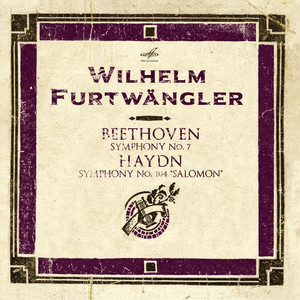
Beethoven: Symphony No. 7 - Haydn: Symphony No. 104 (Live)
- 指挥: Wilhelm Furtwängler (威尔海姆·富特文格勒)
- 歌唱: Berlin Philharmonic/ Vienna Philharmonic
- 发行时间:2006-07-18
- 唱片公司:JSC "Firma Melodiya"
- 类型:录音室专辑
- 歌曲
- 时长
-
作品集:Symphony No. 7 in A Major, Op. 92
-
作品集:Symphony No. 104 in D Major, Hob. I:104 "Salomon"
简介
Wilhelm Furtwängler专辑介绍:Beethoven: Symphony No. 7 in A major, Op. 92 (Live recording: Berlin, 31.10.1943) Haydn: Symphony No. 104 in D major 'London' (Live recording: Munich, 30.07.1944) These fascinating and important recordings by Wilhelm Furtwängler and the Berlin Philharmonic were recorded in Berlin during the Second World War. The Reich Radio Company (RRG) recorded these Furtwängler concerts using the recently developed magnetic tape recorder (Magnetophon) between February 1942 and January 1945. These tapes vividly captured the peak of Furtwänglers art. In April 1945, after the occupation of Berlin by the Soviet army, these tapes were taken back to the Soviet Union. Many of the recordings were issued some ten years after the end of the War, when the state-run record company Melodiya issued LP’s from the tapes - they were not generally known in the West for another decade and information became abundant only after the collapse of the Soviet Union in 1991. In the immediate post-war years, the Furtwängler war-time tapes were broadcast on Moscow Radio and these recordings certainly had a profound impact on musicians in the Soviet Union and some indeed changed their perception of music after listening to Furtwänglers interpretations. This included some of the “Moscow school”; Svetlanov, Kondrashin, Rozhdestvensky, and the young David Oistrakh. There was one factor above all which drew Russian audiences to these performances and that was the visceral electricity to be found listening to these live recordings, whilst Furtwänglers musicians were playing to packed halls during a break in RAF bombing raids. These Melodiya recordings bring to light performances of the war-years which have an intensity often absent from post-war recordings by the conductor. The German maestro’s concerts were recorded on magnetic tape granting a superior fidelity not normally obtainable. These ground-breaking machines gave a true representation of a live concert, capturing the atmosphere of a packed concert using three microphones - never before had such advanced techniques been used to recreate a concert. Because of this, Furtwängler changed his ambivalence to recording and these broadcasts became a staple part of his work from 1941.

